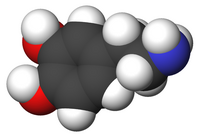
Photo from wikipedia
Abstract Background Tardive dyskinesia (TD) results from exposure to dopamine-receptor antagonists (DRAs), such as typical and atypical antipsychotics. Clinicians commonly manage TD by reducing the dose of or stopping the… Click to show full abstract
Abstract Background Tardive dyskinesia (TD) results from exposure to dopamine-receptor antagonists (DRAs), such as typical and atypical antipsychotics. Clinicians commonly manage TD by reducing the dose of or stopping the causative agent; however, this may cause psychiatric relapse and worsen quality of life. In the 12-week ARM-TD and AIM-TD trials, deutetrabenazine demonstrated statistically significant improvements in Abnormal Involuntary Movement Scale (AIMS) scores versus placebo and was generally well tolerated, regardless of baseline DRA use or comorbidities. Study Objective To evaluate the impact of underlying disease and current DRA use on efficacy and safety of long-term therapy of deutetrabenazine in patients with TD. Method Patients with TD who completed ARM-TD or AIM-TD were eligible to enter this open-label, single-arm, long-term extension after completing the 1-week washout period and final evaluation in the blinded portion of the trial. Change in AIMS scores from baseline to Week 54 and patients “Much Improved” or “Very Much Improved” (treatment success) on the Clinical Global Impression of Change (CGIC) and Patient Global Impression of Change (PGIC) at Week 54 were analyzed by baseline psychiatric illness type, including mood disorders (bipolar disorder/depression/other) or psychotic disorders (schizophrenia/schizoaffective disorder), and presence or absence of current DRA use. Results At Week 54, meaningful improvements from baseline in mean (standard error) AIMS scores were observed for patients with baseline mood disorders (–5.2[0.93]) and psychotic disorders (–5.0[0.63]), and in patients currently using DRAs (–4.6[0.54]) or not using DRAs (–6.4[1.27]). Most patients with mood disorders (73%) and psychotic disorders (71%) were “Much Improved” or “Very Much Improved” on CGIC at Week 54, similar to patients currently using (71%) or not using (74%) DRAs. The majority of patients with mood disorders (62%) and psychotic disorders (57%), as well as patients currently using (58%) or not using (63%) DRAs, were also “Much Improved” or “Very Much Improved” on PGIC at Week 54. Prior treatment in ARM-TD and AIM-TD did not impact the long-term treatment response. Underlying psychiatric disorder and concomitant DRA use did not impact the occurrence of adverse events (AEs). The frequencies of dose reductions, dose suspensions, and withdrawals due to AEs were low, regardless of baseline psychiatric comorbidities and DRAuse. Conclusions Long-term deutetrabenazine treatment demonstrated meaningful improvements in abnormal movements in TD patients, which were recognized by clinicians and patients, regardless of underlying psychiatric illness or DRAuse. Presented at: American Psychiatric Association Annual Meeting; May 5–9, 2018, New York, New York, USA Funding Acknowledgements: This study was supported by Teva Pharmaceuticals, Petach Tikva, Israel.
Journal Title: CNS Spectrums
Year Published: 2019
Link to full text (if available)
Share on Social Media: Sign Up to like & get
recommendations!